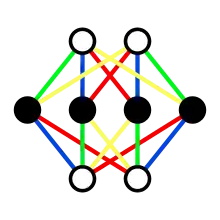Adinkra symbols (physics)
In supergravity and supersymmetric representation theory, Adinkra symbols are a graphical representation of supersymmetric algebras.[1][2][3][4][5] Mathematically they can be described as colored finite connected simple graphs, that are bipartite and n-regular.[6] Their name is derived from Adinkra symbols of the same name, and they were introduced by Michael Faux and Sylvester James Gates in 2004.[1]

Overview
One approach to the representation theory of super Lie algebras is to restrict attention to representations in one space-time dimension and having supersymmetry generators, i.e., to superalgebras. In that case, the defining algebraic relationship among the supersymmetry generators reduces to
- .
Here denotes partial differentiation along the single space-time coordinate. One simple realization of the algebra consists of a single bosonic field , a fermionic field , and a generator which acts as
- ,
- .
Since we have just one supersymmetry generator in this case, the superalgebra relation reduces to , which is clearly satisfied. We can represent this algebra graphically using one solid vertex, one hollow vertex, and a single colored edge connecting them.
See also
References
- Faux, M.; Gates, S. J. (2005). "Adinkras: A graphical technology for supersymmetric representation theory". Physical Review D. 71 (6): 065002. arXiv:hep-th/0408004. Bibcode:2005PhRvD..71f5002F. doi:10.1103/PhysRevD.71.065002. S2CID 18179363.
- S. James Gates Jr.: "Superstring Theory: The DNA of Reality Archived September 26, 2007, at the Wayback Machine" (The Teaching Company)
- S.J. Gates, Jr.: "Symbols of Power, Physics World, Vol. 23, No 6, June 2010, pp. 34 - 39" Archived July 26, 2011, at the Wayback Machine
- S.J. Gates, Jr.: "Quarks to Cosmos Archived March 19, 2011, at the Wayback Machine"
- S.J. Gates, Jr., and T. Hubsch, "On Dimensional Extension of Supersymmetry: From Worldlines to Worldsheets"
- Zhang, Yan X. (2011). "Adinkras for Mathematicians". arXiv:1111.6055 [math.CO].
External links
- http://golem.ph.utexas.edu/category/2007/08/adinkras.html
- https://www.flickr.com/photos/science_and_thecity/2796684536/
- https://www.flickr.com/photos/science_and_thecity/2795836787/
- http://www.thegreatcourses.com/courses/superstring-theory-the-dna-of-reality.html